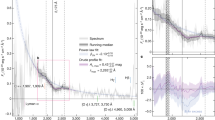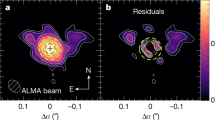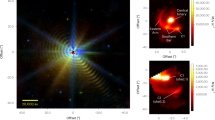Abstract
An intermediate-mass star ends its life by ejecting the bulk of its envelope in a slow, dense wind1,2,3. Stellar pulsations are thought to elevate gas to an altitude cool enough for the condensation of dust1, which is then accelerated by radiation pressure, entraining the gas and driving the wind2,4,5. Explaining the amount of mass loss, however, has been a problem because of the difficulty of observing tenuous gas and dust only tens of milliarcseconds from the star. For this reason, there is no consensus on the way sufficient momentum is transferred from the light from the star to the outflow. Here we report spatially resolved, multiwavelength observations of circumstellar dust shells of three stars on the asymptotic giant branch of the Hertzsprung–Russell diagram. When imaged in scattered light, dust shells were found at remarkably small radii (less than about two stellar radii) and with unexpectedly large grains (about 300 nanometres in radius). This proximity to the photosphere argues for dust species that are transparent to the light from the star and, therefore, resistant to sublimation by the intense radiation field. Although transparency usually implies insufficient radiative pressure to drive a wind6,7, the radiation field can accelerate these large grains through photon scattering rather than absorption8—a plausible mass loss mechanism for lower-amplitude pulsating stars.
This is a preview of subscription content, access via your institution
Access options
Subscribe to this journal
Receive 51 print issues and online access
$199.00 per year
only $3.90 per issue
Buy this article
- Purchase on Springer Link
- Instant access to full article PDF
Prices may be subject to local taxes which are calculated during checkout




Similar content being viewed by others
References
Wood, P. R. Pulsation and mass loss in Mira variables. Astrophys. J. 227, 220–231 (1979)
Habing, H. J. Circumstellar envelopes and asymptotic giant branch stars. Astron. Astrophys. Rev. 7, 97–207 (1996)
Marengo, M. A review of AGB mass loss imaging techniques. Proc. Astron. Soc. Aust. 26, 365–371 (2009)
Gustafsson, B. & Höfner, S. Asymptotic Giant Branch Stars (eds Habing, H. J. & Olofsson, H. ) Ch. 4 (Springer, 2004)
Höfner, S. Dust formation and winds around evolved stars: the good, the bad and the ugly cases. Astron. Soc. Pacif. Conf. Ser. 414, 3–21 (2009)
Woitke, P. Too little radiation pressure on dust in the winds of oxygen-rich AGB stars. Astron. Astrophys. 460, L9–L12 (2006)
Ireland, M. J. & Scholz, M. Observable effects of dust formation in dynamic atmospheres of M-type Mira variables. Mon. Not. R. Astron. Soc. 367, 1585–1593 (2006)
Höfner, S. Winds of M-type AGB stars driven by micron-sized grains. Astron. Astrophys. 491, L1–L4 (2008)
Tuthill, P. G., Monnier, J. D., Danchi, W. C., Wishnow, E. H. & Haniff, C. A. Michelson interferometry with the Keck I Telescope. Publ. Astron. Soc. Pacif. 112, 555–565 (2000)
Lacour, S. et al. Sparse aperture masking at the VLT. I. Faint companion detection limits for the two debris disk stars HD 92945 and HD 141569. Astron. Astrophys. 532, A72 (2011)
Wittkowski, M. et al. The extended atmospheres of Mira variables probed by VLTI, VLBA, and APEX. Astron. Soc. Pacif. Conf. Ser. 445, 107–112 (2011)
Ireland, M. J., Tuthill, P. G., Davis, J. & Tango, W. Dust scattering in the Miras R Car and RR Sco resolved by optical interferometric polarimetry. Mon. Not. R. Astron. Soc. 361, 337–344 (2005)
Waters, L. B. F. M. et al. Mineralogy of oxygen-rich dust shells. Astron. Astrophys. 315, L361–L364 (1996)
Gail, H.-P. in Astromineralogy (ed Henning, T. K. ) 55–120 (Lect. Notes Phys. 609, Springer, 2003)
Draine, B. T. Interstellar dust grains. Annu. Rev. Astron. Astrophys. 41, 241–289 (2003)
Frisch, P. C. et al. Dust in the local interstellar wind. Astrophys. J. 525, 492–516 (1999)
Weingartner, J. C. & Draine, B. T. Dust grain-size distributions and extinction in the Milky Way, Large Magellanic Cloud, and Small Magellanic Cloud. Astrophys. J. 548, 296–309 (2001)
Lagadec, E. & Zijlstra, A. A. The trigger of the asymptotic giant branch superwind: the importance of carbon. Mon. Not. R. Astron. Soc. 390, L59–L63 (2008)
Ireland, M. J., Scholz, M. & Wood, P. R. Dynamical opacity-sampling models of Mira variables - II. Time-dependent atmospheric structure and observable properties of four M-type model series. Mon. Not. R. Astron. Soc. 418, 114–128 (2011)
Loup, C., Forveille, T., Omont, A. & Paul, J. F. CO and HCN observations of circumstellar envelopes. A catalogue—mass loss rates and distributions. Astron. Astrophys. Suppl. Ser. 99, 291–377 (1993)
Olofsson, H., González Delgado, D., Kerschbaum, F. & Schöier, F. L. Mass loss rates of a sample of irregular and semiregular M-type AGB-variables. Astron. Astrophys. 391, 1053–1067 (2002)
van Leeuwen, F. Validation of the new Hipparcos reduction. Astron. Astrophys. 474, 653–664 (2007)
Jäger, C., Dorschner, J., Mutschke, H., Posch, T. & Henning, T. Steps toward interstellar silicate mineralogy. VII. Spectral properties and crystallization behaviour of magnesium silicates produced by the sol-gel method. Astron. Astrophys. 408, 193–204 (2003)
Lenzen, R. et al. NAOS-CONICA first on sky results in a variety of observing modes. Proc. SPIE 4841, 944–952 (2003)
Tuthill, P. et al. Sparse aperture masking (SAM) at NAOS/CONICA on the VLT. Proc. SPIE 7735, 77351O (2010)
Acknowledgements
This work was based on observations collected with the NACO instrument at the European Southern Observatory, Chile.
Author information
Authors and Affiliations
Contributions
P.G.T., M.J.I. and S.L. commissioned the SAMPol observing mode and conducted the initial observations, and developed the standard aperture-masking data reduction pipeline. B.R.M.N. developed the polarimetric data reduction and modelling/fitting procedures, analysed the data and conducted later observations. T.M.E. and P.S. contributed to the data analysis procedures. T.R.B., A.A.Z. and F.L. contributed to both the observing programme and the interpretation of the findings.
Corresponding author
Ethics declarations
Competing interests
The authors declare no competing financial interests.
Supplementary information
Supplementary Information
This file contains Supplementary Text, Supplementary Figures 1-2 and additional references. The Supplementary Text contains a detailed description of the modelling process used in these investigations and additional discussion regarding other dust species. This section also refers to Supplementary Figure 1, a diagram explaining the geometry of the model used. Supplementary Figure 2 shows a diagram demonstrating how starlight becomes polarised by a spherical scattering shell. (PDF 767 kb)
Rights and permissions
About this article
Cite this article
Norris, B., Tuthill, P., Ireland, M. et al. A close halo of large transparent grains around extreme red giant stars. Nature 484, 220–222 (2012). https://doi.org/10.1038/nature10935
Received:
Accepted:
Published:
Issue Date:
DOI: https://doi.org/10.1038/nature10935
This article is cited by
-
Atmospheric molecular blobs shape up circumstellar envelopes of AGB stars
Nature (2023)
-
Sounding-rocket microgravity experiments on alumina dust
Nature Communications (2018)
-
Mass loss of stars on the asymptotic giant branch
The Astronomy and Astrophysics Review (2018)
-
Fresh light on stardust
Nature (2012)
Comments
By submitting a comment you agree to abide by our Terms and Community Guidelines. If you find something abusive or that does not comply with our terms or guidelines please flag it as inappropriate.



